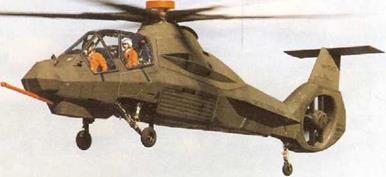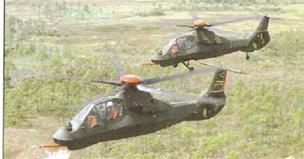Boeing/Sikorsky RAH-66 Comanche Advanced scout helicopter

|
T |
he US Army issued its LHX (Light Helicopter Experimental) requirement in 1982, initially calling tor 5,000 helicopters to replace UH-1, AH-1, OH-6 and OH-58 scout/attack/assault aircraft. By 1990 this number had been cut back to 1,292 aircraft tor the scout/attack role only. Boeing/Sikorsky’s ‘First Team’ was awarded the contract (over the Bell/ McDonnell Douglas ‘Super Team’) for three (later two) YRAH-66 dem/val aircraft on 5 April 1991
The RAH-66 Comanche has a five-bladed all – composite bearingless main rotor and an eight-bladcd tan-in-fin shrouded tail rotor Its largely composite airframe is designed for low observability, employing a degree of faceting and sunken-notch intakes for the two LHTEC T800 turboshafts. The undercarriage is retractable, and all weapons are housed internally, with missiles carried in bays on t. ne fuselage sides, directly attached to the bay doors which act as pylons when they are open, A chin turret will house a 20-mm cannon, and in the extreme nose is a sensor turret for a FLIR and a laser designator. The Longbow MMW radar of the AH-64D Apache will also be fitted in a radome above the main rotor.
The Army has specified maximum avionics commonality with the USAF’s F-22 and the Comanche pilot (front) and WSO each have two flat screen MFDs for presentation of tactical situation, moving map and FLIR/TV information, The pilot also has a wide field-of-view helmet-mounted display system, allied to an electro-optical night navigation and
The Comanche is lighter but only slightly smaller than the AH-64, and will back up – but not replace – the Apache in the combat role.
targeting systems. Flight control is by a triplex fly-by-wire system, with sidestick cyclic-pitch controls. The RAH-66 also features a wide array of defensive equipment, including laser – IR – and radar-warning receivers, RF and IR jammers.
Work on the first prototype began in November 1993, and it flew on 4 January 1996. The early flight test programme was slowed by gearbox failures, but by August 1997 progress was being made once more. The second aircraft was rolled out in April 1998 and made its maiden flight on 30 March 1999. One 1 June 2000 the RAH-66 was approved to enter its engineering and manufacturing development (EMD) phase Boeing/Sikorsky will build 13 FMD RAH-66s, and the Army hopes to then acquire an interim batch of 12 aircraft between EMD and the launch of initial low-rate production, in 2006. The first EMD aircraft will fly in 2004. The US Army’s 2000 Aviation Force Modernization Plan still recommends the acquisition of 1,213 Comanches, valued at nearly 534 billion. I he first RAH-66s are scheduled to be operational in December 2006.
The Boeing/Sikorsky team has now rebuilt one RAH-66 with a revised empennage and tail and also added a radome for the Longbow radar.
|

United Kingdom










